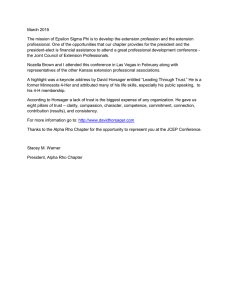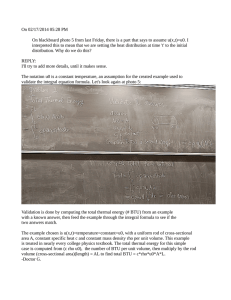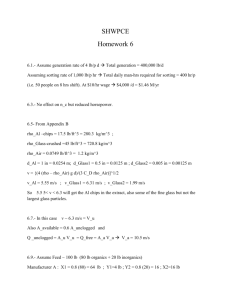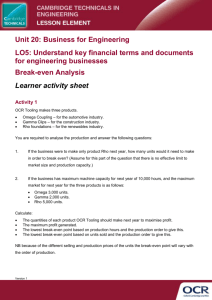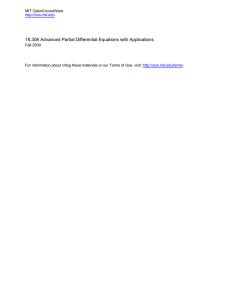ex5m4_7.doc
advertisement
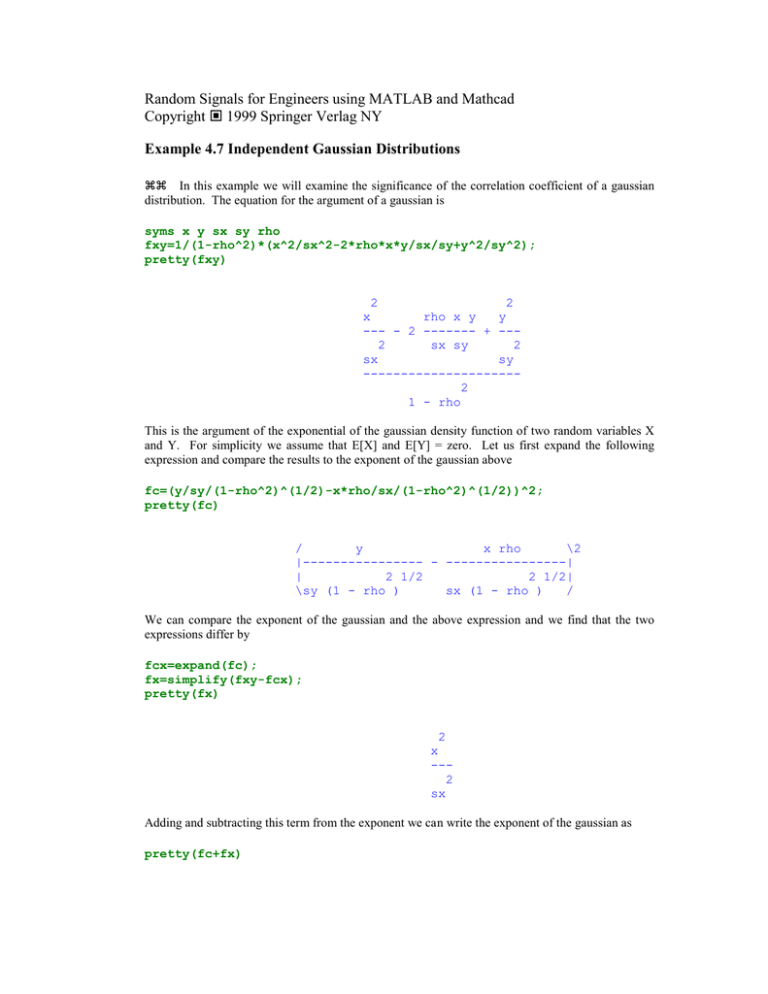
Random Signals for Engineers using MATLAB and Mathcad Copyright 1999 Springer Verlag NY Example 4.7 Independent Gaussian Distributions In this example we will examine the significance of the correlation coefficient of a gaussian distribution. The equation for the argument of a gaussian is syms x y sx sy rho fxy=1/(1-rho^2)*(x^2/sx^2-2*rho*x*y/sx/sy+y^2/sy^2); pretty(fxy) 2 2 x rho x y y --- - 2 ------- + --2 sx sy 2 sx sy --------------------2 1 - rho This is the argument of the exponential of the gaussian density function of two random variables X and Y. For simplicity we assume that E[X] and E[Y] = zero. Let us first expand the following expression and compare the results to the exponent of the gaussian above fc=(y/sy/(1-rho^2)^(1/2)-x*rho/sx/(1-rho^2)^(1/2))^2; pretty(fc) / y x rho \2 |---------------- - ----------------| | 2 1/2 2 1/2| \sy (1 - rho ) sx (1 - rho ) / We can compare the exponent of the gaussian and the above expression and we find that the two expressions differ by fcx=expand(fc); fx=simplify(fxy-fcx); pretty(fx) 2 x --2 sx Adding and subtracting this term from the exponent we can write the exponent of the gaussian as pretty(fc+fx) 2 / y x rho \2 x |---------------- - ----------------| + --| 2 1/2 2 1/2| 2 \sy (1 - rho ) sx (1 - rho ) / sx We now compute the conditioned gaussian density function or f ( y| X x ) f ( x, y) f ( x) The expanded exponent can be used to simplify the computation of the numerator and denominator of the density function by performing the following transformation from z=f(xy) and w=x pretty( [y/sy/(1-rho^2)^(1/2)-x*rho/sx/(1-rho^2)^(1/2); x ]) [ y x rho ] [---------------- - ----------------] [ 2 1/2 2 1/2] [sy (1 - rho ) sx (1 - rho ) ] [ ] [ x ] The Jacobian of this transformation is jac=jacobian([y/sy/(1-rho^2)^(1/2)-x*rho/sx/(1-rho^2)^(1/2);x],[x y]) djac=det(jac) jac = [ -rho/sx/(1-rho^2)^(1/2), [ 1, djac = -1/sy/(1-rho^2)^(1/2) 1/sy/(1-rho^2)^(1/2)] 0] syms z w z= y/sy/(1-rho^2)^(1/2)-x*rho/sx/(1-rho^2)^(1/2) z = y/sy/(1-rho^2)^(1/2)-x*rho/sx/(1-rho^2)^(1/2) The marginal density function is found by integrating over z or f x f w f z, w dz f ( z , w) e 1 w2 2 x2 2 x y 1 f ( w) 1 2 x e 2 e 1 w2 2 x2 1 z 2 2 e z2 2 y 1 2 dz 2 The integral in z is just a normal gaussian and equal to Since f(w) is just f(x) we have f ( x) 1 e 2 x 1 x2 2 x2 The numerator has already been expanded in terms of z and the denominator just cancels the f(x) term to obtain f ( y X x) 1 2 y 1 exp 2 2 1 2 y2 1 2 x y x y For simplicity we have assumed the x and y have zero means. If we were to replace the means in the above expression by substitution of x = x' - ax and y = y' - ay and then dropping the prime, the resultant expression now contains the means. We recognize that the conditional expression is just a gaussian density function in y with the mean ay x x a x y and a variance of 1 2 The expected value of this expression is EY X x a y 2 y x x a x y It is easy to show that the COV[X Y ] = x y by multiplying the density function by x / x and y /y and changing variables to z and w and performing the integration. The above expression can be used to show the independence of the two gaussian variables X and Y. When X and Y are uncorrelated or the COV[X Y] = 0 then = 0. The expected value of y, given that we know X=x, is just the expected value of y plus scaled by the ratio of the variances of y and x time x - ax. This means that y is a linear function of x. It is interesting to take the limit of the conditional density function as ± 1. The variance about the conditional mean approaches zero and the conditional density function of y approaches a delta function at the conditional mean. This says that y approaches the conditional mean with probability one. A matrix can be used to express the variance and covariance of the joint random variables X and Y. This matrix representation is useful for multiple random variables. We express the covariance matrix, K as K=[sx^2 rho*sx*sy ; rho*sx*sy sy^2] K = [ sx^2, rho*sx*sy] [ rho*sx*sy, sy^2] Matlab can be used to invert the matrix K. pretty(K^(-1)) [ 1 [- --------------[ 2 2 [ sx (-1 + rho ) [ [ rho [----------------[ 2 [sx sy (-1 + rho ) rho ] -----------------] 2 ] sx sy (-1 + rho )] ] 1 ] - ---------------] 2 2 ] sy (-1 + rho )] The determinant can also be computed as det(K) ans = sx^2*sy^2-rho^2*sx^2*sy^2 We notice by direct multiplication that the matrix expression E=[x y]*K^(-1)*[x y].'; pretty(simplify(E)) 2 2 2 2 x sy - 2 x sy y rho sx + y sx - --------------------------------2 2 2 sx sy (-1 + rho ) The last expression is just the exponent of the gaussian density function and we may write the gaussian density in matrix form as f x, y 1 exp x 2 K 2 1 x y K 1 y
